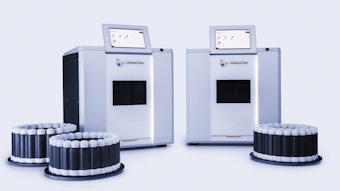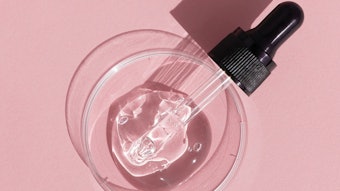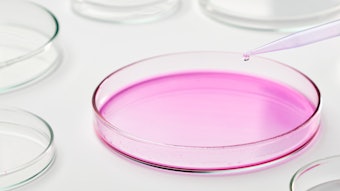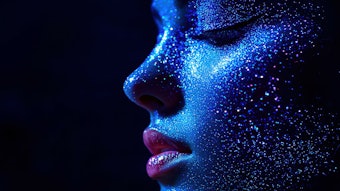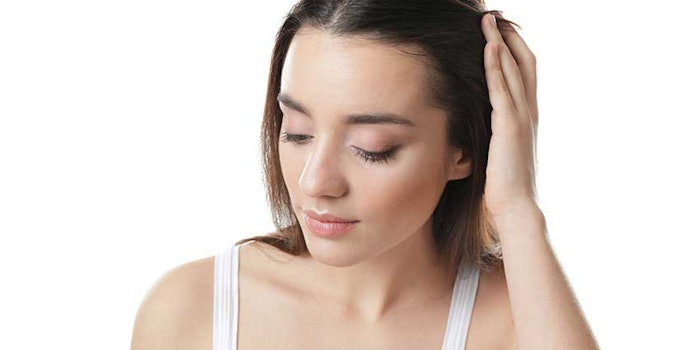
Scalp irritation is defined as dermatitis of the scalp1 caused by the contact of chemical, physical or biological agents, although endogenous factors such as impaired barrier function and pre-existing dermatitis may also play a role.2 Its clinical manifestations can range from mild to severe, with signs and symptoms such as erythema, blister formation, burning/tingling scalp and scalp severe acute irritant dermatitis, which is also known as scalp burn or cosmetic alopecia.3–5 The four clinical entities are: acute (burn), sensory, non-immunologic contact urticaria (NICU) and cumulative. While scalp irritation also can be caused by contact with physical or biological agents, this column will discuss the irritation resulting from hair chemicals. The desire for a specific hairstyle or color can render the scalp exposed to different hair chemicals that may result to scalp irritation.
Scalp Severe Acute Irritant Dermatitis (Chemical Burn)
Common hair substances that may cause acute scalp irritation are relaxers and hair highlighting chemicals.4, 5 Acute scalp burn—because of the marked damage—deserves detailed investigation, and should be modeled in vitro. Relaxers are classified into two groups—lye, mostly sodium hydroxide; and no-lye, mostly guanidine hydroxide.5 According to the U.S. Food and Drug Administration (FDA), “Any relaxer can burn the scalp if used the wrong way.”6 However, lye-containing hair relaxers are known to cause more scalp burn than hair relaxers without lye. The adverse effects of relaxer exposure are contact dermatitis7 and hair breakage with alopecia, which may also include scarring.8, 9 (Additional information on relaxers is available in “Formula Anatomy Deciphered—Hair Relaxers and Straighteners” by Luigi Rigano, PhD, published in the November 2012 issue of Cosmetics & Toiletries.)
Khumalo et al. studied five women of African descent with a history of scalp discomfort. Their scalp discomfort started during or within minutes of a salon hair relaxation procedure, lasted for a few days and healed with scarring alopecia, specifically central centrifugal cicatricial alopecia (CCCA).5 Lye-containing hair relaxers were used in three women, while no-lye containing relaxers were utilized in the other two. In addition to irritation caused by the relaxer chemicals, other factors causing irritation included relaxers applied for a longer time than recommended, and hair relaxed more frequently than the recommended six to eight weeks.5 Other implicated but unlikely etiologic factors for scarring alopecia were: stylists mixing the relaxer in incorrect proportions; poor salon facilities, e.g., lack of running water; contact dermatitis; and hairdressers buying large quantities and transferring them into smaller, unlabeled containers such that users were unaware of whether the relaxer used was lye-containing. Public education would help clarify the possibility of product-association with CCCA.5 The frequent correlation of insidious onset of CCCA and scalp burn from hair relaxers warrants further investigation to establish a clear-cut pathogenesis of each condition.5
Chan and Maibach reviewed eight hair highlighting cases that resulted in scalp burn. These treatments were reported in three adults and five children, and possible causes were: use of incorrect hydrogen peroxide concentration, inadvertent spillage of the heated chemicals, contact between the heated aluminium foil and the scalp, pediatric scalp sensitivity, and toxic reaction to the chemicals.4, 10–15 Incorrect hydrogen peroxide concentration and contact between the heated aluminium foil and the scalp resulted mainly from the faulty practices of the hair stylist.4, 10–15 Toxic reactions from hair highlighting products may necessitate a review of their chemical levels.4 All cases resulted in scarring alopecia and were managed medically and surgically.
Moreover, burn scars may degenerate into malignancy.16 Thus, the importance of knowing the caustic nature of the highlighting chemicals and observing the proper application technique are vital for prevention.4 The authors propose that hair highlighting product manufacturers consider labeling their products for adult-use only to spare children from unnecessary harm; the possibility is highly likely that pediatric scalp is more sensitive than adult scalp to highlighting chemicals.
Sensory Irritation of the Scalp
Sensory irritation of the scalp may be defined as itching, stinging, burning or tingling sensations of the scalp upon contact with certain chemicals in the absence of clinical signs.17 These subjective symptoms occur within seconds to minutes following chemical exposure. Although the pathomechanism of sensory irritation is unknown, variables such as the quality of the chemical and its concentration affect its outcome. Neural pathways may also play a role. The lactic acid stinging test (LAST) is used to study this type of irritation and is based on self-perceived assessment.17, 18 Thus, the threshold for this reaction differs between subjects.17
Using oxidative hair dyes such as hydrogen peroxide and strong alkalis have resulted in sensory irritation of the face and scalp.19 Fujita et al. utilized a self-assessment questionnaire to measure the sensory irritation in various regions of the body caused by two model hair dye bases that contained different amounts of alkali agents without dyes. The occipital region was found as an alternative region of the scalp to test for sensory irritation of the hair dye bases. This study’s outcome suggests that sensory irritation caused by hair dye bases could occur easily on a damaged dry scalp, caused by the decreased TEWL.19
Non-immunologic Contact Urticaria (NICU) of the Scalp
NICU is a frequent type of immediate contact reaction and occurs without prior sensitization.20 One study reported marked variation in susceptibility to NICU agents, with the most sensitive area being the face—followed by the elbow pit, the upper back, the upper arm, the volar forearm and the lower back.21
Zhai et al. reported that NICU studies of the scalp have not been published,22 thus the researchers compared the reactivity of the scalp, face and back to the non-immunologic urticants benzoic acid (BN), a preservative in cosmetics, and hexyl nicotinate (HN), a skin conditioning agent. The researchers ascertained relative responsiveness in 10 bald males utilizing visual scores (VS), a visual analogue scale (VAS) and biophysical instruments at baseline, 15 min, 30 min and 60 min post-application.22 Results were varied, since the three sites belong to three different regions of the body and have specific diffusion pathways for each NICU urticant.23, 24
Cumulative Irritation of the Scalp
Cumulative irritation refers to irritation occurring after repetitive application over days, weeks or even years, and is characterized by dry and/or scaly scalp.3, 17 Since the scalp does not readily show erythema, relatively few studies have been performed to demonstrate cumulative irritancy potential of hair products such as shampoos and conditioners.22 It is hypothesized, based on consumer complaints, that this arena justifies closer examination. Although poorly understood, the 21-day cumulative irritancy and comparative back-scalp studies might yield insight into this neglected field.22
Conclusions
Cosmetic hair products are often implicated to cause scalp irritation.25 However, preventing this irritation is not the sole responsibility of the manufacturers—consumers and especially hair dressers also share this responsibility. As manufacturers comply with regulatory directives in a given country, they are encouraged to provide consumer awareness in cooperation with regulators. Furthermore, hairstylists must apply hair chemicals with utmost care and be knowledgeable of the caustic nature of some of these materials.4 Lastly, consumers should be encouraged to learn about the possible outcomes of using hair care products and procedures to prevent the possible occurrence of adverse consequences.
References
Send e-mail to [email protected].
- M Fishbein, Modern Health Medical Adviser, 2nd ed, Garden City Publishing, New York, USA (1969)
- A Amado, JS Taylor and A Sood, Irritant Contact Dermatitis, in Fitzpatrick’s Dermatology in General Medicine, 7th ed, K Wolf, LA Goldsmith and BA Gilchrist et al, eds, McGraw Hill Co., New York, USA (2008) pp 395–401
- JM Lachapelle, Irritant Dermatitis of the Scalp, in Irritant Dermatitis, AL Chew and HI Maibach, eds, Springer, Verlag-Berlin-Heidelberg, Germany (2006) pp 81–88
- HP Chan and HI Maibach, Hair highlights and severe acute irritant dermatitis (“burn”) of the scalp, Cutan Ocul Toxicol 29(4) 229–33 (2010)
- NP Khumalo, K Pillay and RM Ngwanya, Acute ‘relaxer’-associated scarring alopecia: a report of five cases, Br J Dermatol 156(6) 1394–1397 (2007)
- Hair Dye and Hair Relaxers, www.fda.gov/ForConsumers/ByAudience/ForWomen/ucm118527.htm (Accessed Nov 25, 2012)
- BJ Kaur, H Singh and A Lin-Greenberg, Irritant contact dermatitis complicated by deep-seated staphylococcal infection caused by hair relaxer, J Natl Med Assoc 94(2) 121–123 (2002)
- AG Nicholson, CC Harland, RH Bull, et al., Chemical induced cosmetic alopecia, Br J Dermatol 128(5) 537–541 (1993)
- JJ Miller, Relaxer-induced alopecia, Am J Contact Derm 12(2) 238–239 (2001)
- P Goon and A Misra, A possible chemical burn to the scalp following hair highlights, Burns 31(3) 530–531 (2005)
- P Maguina, M Shah-Khan, G An and M Hanumadass, Chemical scalp burns after hair highlights, J Burn Care Res 28(2) 361–363 (2007)
- W Peters, The hair color-highlighting burn: a unique burn injury, J Burn Care Rehab 21(2) 96–98 (2000)
- JJ Lund, R Unwala, L Xia and V Gottlieb, Chemical scalp burns secondary to the hair highlighting process: clinical and histopathological features, Pediatr Dermatol 27(1) 74–78 (2010)
- CM Schröder, D Höller Obrikeit, HF Merk and F Abuzahara, Necrotizing toxic contact dermatitis of the scalp from hydrogen peroxide [in German], Hautartz 59(2) 148–150 (2008)
- CD Jensen and H Sosted, Chemical burns to scalp from hair bleach and dye, Acta Dermatol Venereol 86(5) 461–462 (2006)
- DA Whiting, Traumatic alopecia, Int J Dermatol 38(suppl 1) 33–44 (1999)
- AL Chew and HI Maibach, Ten Genotypes of Irritant Contact Dermatitis, in Irritant Dermatitis, AL Chew and HI Maibach, eds, Springer, Verlag-Berlin-Heidelberg, Germany (2006) pp 5–9
- M Breternitz, JW Flurh and E Berardesca, Technical Bases of Biophysical Instruments Used in Sensitive Skin Testing, in Sensitive Skin Syndrome, E Berardesca, JW Flurh and HI Maibach, eds, Taylor & Francis Group, LLC, New York, USA (2006) pp 75–106
- F Fujita, T Azuma, M Tajiri, H Okamoto, M Sano and M Tominga, Significance of hair-dye base-induced sensory irritation, Int J Cosmet Sci, 32(3) 217–224 (2010)
- S Amin, A Lahti and HI Maibach, Contact urticaria and the contact urticaria syndrome (immediate contact reactions), in Dermatotoxicology, 7th ed, H Zhai, KP Wilhelm and HI Maibach, eds, CRC Press, Boca Raton, FL USA (2008) pp 525–536
- R Gollhausen and AM Kligman, Human assay for identifying substances which induce non-allergic contact urticati: the NICU test, Contact Dermatitis 13(2) 98–106 (1985)
- H Zhai, Y Zheng, R Fautz, A Fuchs and HI Maibach, Reactions of non-immunologic contact urticaria on scalp, face and back, Skin Res Technol 2011 Nov 9. doi: 10.1111/j.1600-0846.2011.00590.x. (Epub ahead of print)
- RC Wester and HI Maibach, Cutaneous pharmacokinetics: 10 steps to percutaneous absorption, Drug Metab Rev 14(2) 169–205 (1983)
- RC Wester and HI Maibach, Regional variation in percutaneous absorption: principles and applications to human risk assessment, in Percutaneous absorption: drugs, cosmetics, mechanisms, methods, 4th ed, RL Bronaugh and HI Maibach, eds, Taylor & Francis, Boca Raton, FL USA (2005) pp 85–93
- CL Gummer, Cosmetics and hair loss, Clin Exp Dermatol 27 (5) 418–421 (2002)


